
Union for Peru is a Peruvian political party founded by Javier Pérez de Cuéllar, an ex-UN Secretary General, in 1994 to run for the presidency of Peru in the 1995 general elections. Originally a social democratic party, the party became the main political home of the Peruvian ethnocacerist movement in the late-2010s after a group led by former Army Major Antauro Humala joined the party. Humala later formed the Patriotic Front in 2018 and contested the 2021 general elections.
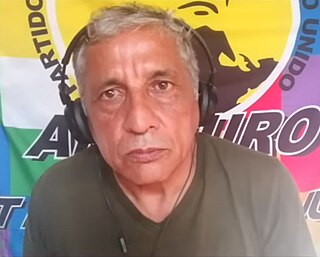
Antauro Igor Humala Tasso is a Peruvian ethnocacerist, a former army major, and nationalist leader.
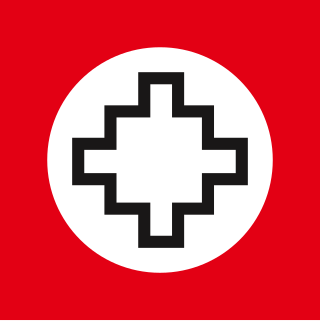
The Ethnocacerist movement is a Peruvian ethnic nationalist movement that espouses an ideology called ethnocacerism. The movement seeks to establish a proletarian dictatorship led by the country's Indigenous communities and their descendants. It draws on the ideas and history of Indigenous and anticolonial movements, including those of Juan Velasco Alvarado, Evo Morales, Abdel Nasser, Muammar Gaddafi, and Che Guevara. Ethnocacerism is considered an Indigenist ideology and is currently represented in mainstream politics by the Union for Peru party and other smaller parties. The ideology is followed by Peruvian militant groups like the Plurinational Association of Tawantinsuyo Reservists and Ejército de Reservistas Andino Amazónico – T.

Javier Diez Canseco Cisneros was a Peruvian politician and member of the Peruvian Congress representing the Socialist Party of Peru (PS), of which he was a founding member and also served as its Party President.
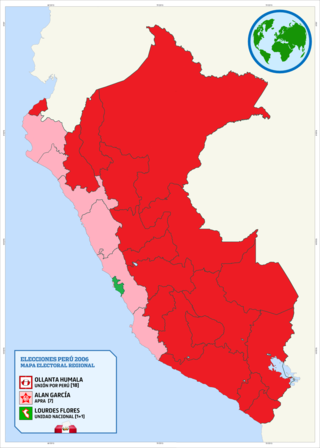
General elections were held in Peru in on 9 April 2006 to elect the President, two Vice-Presidents, 120 members of Congress and five members of the Andean Parliament for the 2006–2011 period. As the no presidential candidate received a majority of the vote, a second round was held on 4 June between the top two candidates, Ollanta Humala and Alan García. Garcia won the run-off with 52.63% to Humala's 47.37%. He was subsequently inaugurated on 28 July 2006, Peruvian Independence Day.
Isaac Humala Núñez is a Peruvian labour lawyer and the ideological leader of the Movimiento Etnocacerista, a group of ethnic nationalists in Peru.

Andahuaylas, founded in 1533 as San Pedro de Andahuaylas «La Grande de la Corona», is a Peruvian city. It is the capital of the Andahuaylas Province in the Apurímac Region. It is known as the pradera de los celajes. Its approximate population of 42,268 inhabitants makes it the largest city in the region.

Ollanta Moisés Humala Tasso is a Peruvian politician and former military officer who served as President of Peru from 2011 to 2016. Originally a socialist and left-wing nationalist, he is considered to have shifted towards neoliberalism and the political centre during his presidency.
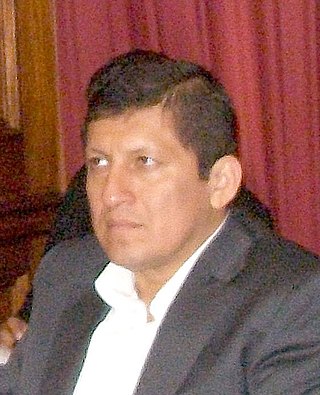
Víctor Isla Rojas is a Peruvian lawyer, businessman and politician. He was a former Congressman representing the Loreto region for two terms, from 2006 to 2016 and was President of the Congress between 2012 and 2013. Before he became a congressman, he was the Vice Governor of Loreto serving between 2003 and 2006 and served as Provincial Councillor of Alto Amazonas.

General elections were held in Peru on 10 April 2011 to elect the President, the Vice Presidents, 130 members of Congress and five members of the Andean Parliament. As no presidential candidate received a majority in the first round, a second round was held on 5 June to determine the successor of outgoing president Alan García. Former army officer Ollanta Humala narrowly defeated Keiko Fujimori, daughter of imprisoned former President Alberto Fujimori. Humala was sworn in as the 94th President of Peru on 28 July.

The Possible Peru Electoral Alliance was an electoral alliance in Peru formed for the 2011 general election, dominated by the eponymous party Possible Peru and led by presidential candidate and ex-president Alejandro Toledo.

Daniel Emiliano Mora Zevallos is a Peruvian military officer and politician belonging to the Possible Peru. He was the first Minister of Defense in Ollanta Humala's government and a Congressman, representing the Constitutional Province of Callao for the 2011–2016 term.
Javier Reátegui Rosello is a Possible Peru Alliance member and a former Peruvian Interior Minister. He resigned in 2005 due to events relating to Antauro Humala occupying a rural police station in Andahuaylas.

2016 attacks in Santo Domingo de Acobamba and Llochegua took place on the eve of the 2016 Peruvian general election, when groups of Shining Path guerrilla fighters armed with long-range rifles and grenades, ambushed a Peruvian military caravan of eight vehicles at Hatun Asha. The ambush began at approximately 5:00 (a.m.), when guerrillas targeted a Peruvian military patrol along a rural road within the Santo Domingo de Acobamba District, located in the District of Huancayo. The vehicles were transporting election ballots and related materials and their transport was handled by soldiers of the 311th Battalion of the Peruvian Armed Forces, who were tasked with guarding polling places in the central Junin region, while the patrol was also to serve in Lima. The ambush left a total of nine government soldiers and two civilian contractors dead as well as five others who escaped wounded. Two hours after the attack, a second attack occurred in Mayapo, on the Llochegua District in Ayacucho, where one police officer was injured and taken to a hospital in Pichari.
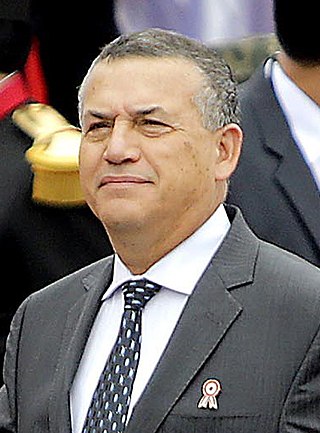
Daniel Belizario Urresti Elera is a Peruvian retired army general and politician who served as Minister of the Interior in the administration of President Ollanta Humala from 2014 to 2015, and as a Congressman representing Lima from 2020 to 2021. He is currently serving a sentence of twelve years in prison for the murder of journalist Hugo Bustíos.

Luis Alberto Otárola Peñaranda is a Peruvian attorney and politician who was the Prime Minister of Peru from 2022 until his resignation in 2024. He previously served as Minister of Defense twice, under Ollanta Humala and Dina Boluarte.
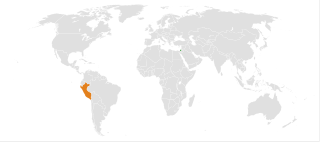
Palestine–Peru relations are bilateral relations between the State of Palestine and Peru. Peru recognized Palestine as a sovereign state on 24 January 2011. Both nations are members of the Non-Aligned Movement. Palestine has an embassy in Lima.
This is a broad timeline of the ongoing 2022–2023 Peruvian protests against the government of Dina Boluarte and the Congress of Peru, sparked by the self-coup attempt of President Pedro Castillo, who was later arrested for his actions. The protests were organized by social organizations and indigenous peoples who felt they experienced political disenfranchisement, specifically on the politically left-wing to far left, with the groups demanding immediate general elections and a constituent assembly to draft a new Constitution of Peru.
The Locumba uprising, also called Locumbazo, was a military uprising that took place in Locumba, Peru, and the Toquepala mine on Sunday, 29 October 2000.

The Plurinational Association of Tawantinsuyo Reservists (ASPRET) is an ethnonationalist paramilitary group, active in the VRAEM conflict zone in Peru. The group is led by Eddy Villarroel Medina, also known as "Comandante Sacha," a former member of the Peruvian Armed Forces. ASPRET's primary objective is to gain political power, and overthrow the Peruvian state. Members of the group call themselves the "guardians of the people" and have participated in riots in Oxapampa and Puerto Bermudez. ASPRET had a short lived alliance with the Militarized Communist Party of Peru from 2017 to 2022, which ended due to ideological differences. The group has also been accused of being connected to Hezbollah, which it denies. Many members of the movement are armed forces veterans of Peru's internal wars or the border disputes with Ecuador in the 1980s and 1990s.
















